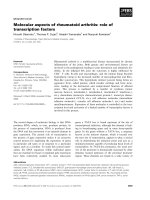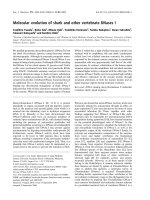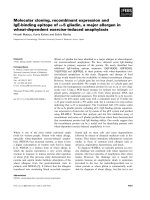Báo cáo khoa học: "Molecular cloning of the cDNA of canine homeodomaininteracting protein kinase 2" ppsx
Bạn đang xem bản rút gọn của tài liệu. Xem và tải ngay bản đầy đủ của tài liệu tại đây (1.11 MB, 5 trang )
JOURNAL OF
Veterinary
Science
J. Vet. Sci. (2005), 6(2), 141–145
Molecular cloning of the cDNA of canine homeodomain-interacting protein
kinase 2
Sook-Yeon Lee, Jin-Young Chung, Il-Seob Shin, Eun-Wha Choi, Cheol-Yong Hwang, Hwa-Young Youn*,
Hong-Ryul Han
Department of Veterinary Internal Medicine, College of Veterinary Medicine and School of Agricultural Biotechnology,
Seoul National University, Seoul 151-742, Korea
The research of p53 is being conducted to find the
mechanisms of tumorigenesis and to treat various cancers.
Homeodomain-interacting protein kinase2 (HIPK2) is an
important factor to regulate p53 and to increase the
stability of p53. Activation of HIPK2 leads to the selective
phosphorylation of p53, resulting in growth arrest and the
enhancement of apoptosis. In this study, the canine
HIPK2 cDNA fragments were obtained, and their
overlapping regions were aligned to give a total sequence
of 3489 bp. The canine HIPK2 cDNA (GenBank accession
number; AY800385) shares 93% and 90% sequence
identity with those of human and mouse HIPK2,
respectively. The canine HIPK2 cDNA contains an open
reading frame encoding 1163 amino acid residues and the
predicted amino acid sequence has 98% and 96% identity
with those of human and mouse, respectively. The
deduced amino acid sequence of canine HIPK2 has also
all domains’ sites compared with human and mouse
HIPK2. Therefore, these structural similarities suggested
that the canine HIPK2 shares the basic biological
functions that HIPK2 exhibit in other species.
Key words: cloning, dog, HIPK2, p53 regulation
Introduction
Homeodomain-interacting protein kinases (HIPKs) constitute
a novel family of nuclear protein kinases. Three members of
this family, HIPK1, HIPK2 and HIPK3 have been isolated
in human and mouse so far but none of those was isolated in
dogs. HIPK2 has been described as a homeodomain-
interacting protein kinase, which acts as a co-repressor for
homeodomain transcription factors [10]. HIPK2 colocalizes
with p53 in nuclear bodies and phosphorylates p53.
The tumor suppressor protein p53 is one of the most
important regulators of cellular growth functions, such as
cell cycle arrest, DNA repair, and apoptosis, and is mutated
in about 50% of all human tumors [8]. The p53 is important
in the cellular response to cellular stresses, UV, γ-lay, and
toxins [2,4,11,16]. Under normal conditions, p53 is a short-
lived protein that is highly regulated and maintained at low
or undetectable levels [11]. However, after stresses, the
activation of p53 coordinates a change in the balance of
gene expression leading to growth arrest, DNA repair or
apoptosis, and these actions prevent the proliferation of
genetically damaged cells. It involves several mechanisms
including post-translational modifications such as phosphorylation
and acetylation of specific residues in the amino-terminal
and carboxy-terminal domains [16,18]. In addition to post-
translational modifications, protein-protein interactions and
subcellular relocalization also have a role in the activation of
p53 [5,17]. The activation of p53 leads to the transcription
of several genes whose products trigger different biological
outcomes [6].
Activation of HIPK2 leads to the selective phosphorylation
of p53 at Ser46, facilitating CBP-mediated acetylation of
p53 at Lys382 and promoting p53-dependent gene expression
[7]. The HIPK2 enhances the expression of p53 target genes,
resulting in growth arrest and the enhancement of apoptosis
[3]. Overexpression of HIPK2 leads to an increase of p53
protein expression or stability [19].
The research of p53 is being conducted to find the
mechanisms of tumorigenesis and to treat various cancers.
Thus, recently the researches are being conducted actively
about the structure, function of HIPK2, and the relationship
between HIPK2 and p53. In dogs, the gene therapy with p53
in cancer patients is in experimental stage.
The study about the nucleotide sequence of canine HIPK2
was performed for the development of cancer therapy
because the attack rate of cancer has been increased
depending on longevity of pets in veterinary field.
*Corresponding author
Tel: +82-2-880-1226; Fax: +82-2-880-1226
E-mail:
142 Sook-Yeon Lee et al.
Fig. 1. Alignment of the nucleotide sequence of canine HIPK2 cDNA with those of human, and mouse counterparts (GenBan
k
accession numbers AF326592 and AF208292). Dots indicate regions of identities in nucleotides. Numbers on left indicate the
nucleotide residue position. Gaps were introduced in sequences to maximize alignment (-). This canine HIPK2 cDNA sequence was
deposited in the GeneBank nucleotide database under accession number AY800385.
Molecular cloning of the cDNA of canine homeodomain-interacting protein kinase 2 143
Materials and Methods
Spinal cord preperation
A physically normal, middle-aged, mixed male dog was
euthanized with 20 ml of thiopental sodium. Spinal cord
was separated and stored until the mRNA extraction was
conducted at −70
C freezer.
Total RNA extraction and synthesis of cDNA
The spinal tissue (30 mg) was disrupted in 1.5 ml tube
with 350 µl of lysis buffer (Macherey-Nagel, Germany) and
was ground with automatic homogenizer. Total RNA was
isolated from spinal tissue with RNA extraction kit
(Macherey-Nagel, Germany). Full-length first strand cDNA
was prepared from total RNA with First Strand cDNA
Synthesis Kit (Fermentas, Lithuania). The cDNA was kept
in −20
C freezer.
Polymerase chain reaction (PCR) was carried out using
the spinal cDNA with primers designed based on conserved
region of human and murine nucleotide sequences (GenBank
Accession No. AF326592 and AF208292). PCR reaction
mixture was consisted with a pair of the primers (1.0 µM
each), Taq polymerase (0.75 units; TaKaRa, Japan), 10×
PCR buffer (10 µl), dNTP mixture (8 µl), template (1 µg)
and deionized water was added to a final volume of 25 µl.
Amplification was involved 35 cycles of denaturation (94
C,
1 min.), annealing (45~60
C, 1 min.) and polymerization
(72
C, 2 min.) steps.
Cloning and nucleotide sequence analysis
The PCR products were extracted by gel extraction kit-
spin (NucleoGen, Korea) and were ligated into pCR2.1-
TOPO vector (Invitrogen, USA). The vector was transformed
into competent E. coli cells. Plasmid DNAs were isolated
with plasmid purification kit (NucleoGen, Korea). The
cloned plasmids were committed to TaKaRa-Korea
Biomedical, in which ABI PRISM 377 sequencer is used to
sequence analysis. The sequences were compared with
Fig. 1. Continued.
144 Sook-Yeon Lee et al.
those of human and murine HIPK2 (GenBank Accession
No. AF326592 and AF208292). The amino acid sequence
of canine HIPK2 was deduced from nucleotide sequence.
Results
About 30 pairs of primers were designed on the conserved
region of human and murine HIPK2 in which 18 pairs of
primers were used to find sequence of canine HIPK2. The
other primers did not make PCR products or made different
sequences products compared with human and murine
HIPK2 sequences.
The clones which had overlapping regions were aligned to
give a total sequence of 3489 bp as shown in Fig. 1. Canine
HIPK2 cDNA sequence elucidated in this study was deposited
in the GeneBank nucleotide database under accession number
AY800385.
The identity between nucleotide sequence of canine
HIPK2 and that of human and murine HIPK2 was 93% and
90%, respectively (Fig. 1). The identity between nucleotide
sequence of human and mouse HIPK2 was 90%.
The canine HIPK2 cDNA contained an open reading
frame encoding 1163 amino acid residues and the predicted
amino acid sequence had 98% and 96% identity with those
of human and mouse, respectively (Fig. 2). The nucleotide
and amino acid sequences were highly conserved between
human, mouse and dog.
Discussion
The nucleotide sequences of canine HIPK2 containing
open reading frame region were found. The canine HIPK2
nucleotide sequence was similar to those of human and
mouse. The deduced amino acid sequence of canine HIPK2
was also very similar to those of human and murine HIPK2.
The spinal cord was selected because HIPK2 mRNA was
detectable in many tissues in human but a relatively high
expression was observed in neural tissues, in which there are
hippocampus, medulla oblongata, putamen, and so on [20].
Further study is needed to know where canine HIPK2 is
expressed highly, using northern blot analysis, dot blot
analysis, semi-quantitative RT-PCR [13,20].
HIPK2 contains multiple functional domains: an interaction
domain for homeoproteins, a corepressor domain, a PEST
sequence, a YH domain in the COOH-terminal and a protein
kinase catalytic domain in the N-terminal side [10]. The
enhancement of repressor activity of homeoproteins by
HIPK2 is conferred by domains within the N-terminal half
of the HIPK2. The SRS (nuclear speckle retention signal)
that contains PEST sequence and YH domain has a positive
and a negative effect on co-repressor activity respectively. It
is expected that the functions of canine HIPK2 were similar
Fig. 2. The deduced amino acid sequences of canine HIPK2 were aligned with those of human and mouse. Dots indicate identities wit
h
amino acids of the canine HIPK2 sequence. Gaps were introduced in sequences to maximize alignment (-).
Molecular cloning of the cDNA of canine homeodomain-interacting protein kinase 2 145
to those of human and murine HIPK2, because the deduced
amino acid sequences of canine HIPK2 contained all these
domains. For instance, HIPK2 acts as a transcriptional
corepressor for homeoproteins and localizes to nuclear
speckles. In the N-terminal of the catalytic domain there is a
glycine-rich stretch of residues in the vicinity of a lysine
residue, which has been shown to be involved in ATP
binding. In the central part of the catalytic domain there is a
conserved aspartic acid residue which is important for the
catalytic activity of the enzyme.
HIPK2 has the function namely activation of transcription
mediated by p53 specific promoter elements [19]. Overexpression
of HIPK2 leads to an increase of the p53 protein level. The
kinase defective mutant of HIPK2 leads to a decrease of p53
protein amounts. Overexpression of HIPK2 does not lead to
a change of Mdm2 mRNA levels, but it leads to a
downregulation of p53-induced Mdm2 protein.
In veterinary field, the attack rate of cancer is increasing
due to the longevity of pets. So, the researches of cancer and
p53 are highlighted and the study of HIPK2 may provide
clinical benefits.
References
1. Ashkenazi A, Dixit VM. Death receptors: signaling and
modulation. Science 1998, 281, 1305-1308.
2. Brown JM, Wouters BG. Apoptosis, p53, and tumor cell
sensitivity to anticancer agents. Cancer Res 1999, 59, 1391-
1399.
3. D’Orazi G, Cecchinelli B, Bruno T, Manni I, Higashimoto
Y, Saito S, Gostissa M, Coen S, Marchetti A, Del Sal G,
Piaggio G, Fanciulli M, Appella E, Soddu S.
Homeodomain-interacting protein kinase-2 phosphorylates
p53 at Ser 46 and mediates apoptosis. Nature Cell Biol 2002,
4, 11-19
4. Fukunaga-Takenaka R, Fukunaga K, Tatemichi M,
Ohshima H. Nitric oxide prevents UV-induced
phosphorylation of the p53 tumor-suppressor protein at
serine 46: a possible role in inhibition of apoptosis. Biochem
Biophys Res Commun 2003, 308, 966-974.
5. Giaccia AJ, Kastan MB. The complexity of modification:
emerging patterns from divergent signals. Genes 1998, 12,
2973-2983.
6. Gottlieb TM, Oren M. p53 in growth control and neoplasis.
Biochim Biophys Acta 1996, 1287, 77-107
7. Hofmann TG, Moller A, Sirma H, Zentgraf H, Taya Y,
Droge W, Will H, Schmitz ML. Regulation of p53 activity
by its interaction with homeodomain-interacting protein
kinase-2. Nature Cell Biol 2002, 4, 1-10.
8. Hollstein M. Somatic point mutations in the p53 gene of
human tumors and cell lines: updated compilation. Nucleic
Acids Res 1996, 24, 141-146.
9. Hsu H, Xiong J, Goeddel DV. The TNF receptor 1-
associated protein TRADD signals cell death and NF-kappa
B activation. Cell 1995, 81, 495-504.
10. Kim YH, Choi CY, Lee SJ, Conti MA, Kim Y.
Homeodomain-interacting protein kinases a novel family of
co-repressors for homeodomain transcription factors. J Biol
Chem 1998, 273, 25875-25879.
11. Ko LJ, Prives C. p53 : puzzle and paradigm. Genes 1996,
10, 1054-1072.
12. Li X, Wang Y, Debatin KM, Hug H. The serine/threonine
kinase HIPK2 interacts with TRADD, but not with CD95 or
TNF-R1 in 293T cells. Biochem Biophys Res Commun
2000, 277, 513-517.
13. Pierantoni GM, Bulfone A, Pentimalli F, Fedele M,
Iuliano R, Santoro M, Chiariotti L, Ballabio A, Fusco A.
The homeodomain-interacting protein kinase 2 gene is
expressed late in embryogenesis and preferentially in retina,
muscle, and neural tissues. Biochem Biophys Res Commun
2002, 290, 942-947.
14. Rochat-Steiner V, Becker K, Micheau O, Schneider P,
Burns K, Tschopp J. FIST/ HIPK3:a Fas/FADD-interacting
serine/threonine kinase that induces FADD phosphor-
rylation and inhibits fas-mediated Jun NH(2)-terminal kinase
activation. J Exp Med 2000,
192, 1165-1174.
15. Trost M, Kochs G, Haller O. Characterization of a novel
serine/threonine kinaseassociated with nuclear bodies. J Biol
Chem 2000, 275, 7373-7377.
16. Vogelstein B, Lane D, Levine AJ. Surfing the p53 network.
Nature 2000, 408, 307-310.
17. Vousden KH. p53:death star. Cell 2000, 103, 691-694.
18. Wahl GM, Carr AM. The evolution of diverse biological
responses to DNA damage: insights from yeast and p53. Nat
Cell Biol 2001, 3, E277-E286.
19. Wang Y, Debatin KM, Hug H. HIPK2 overexpression leads
to stabilization of p53 protein and increased p53
transcriptional activity by decreasing Mdm2 protein levels.
BMC Mol Biol 2001, 2, 8.
20. Wang Y, Hofmann TG, Runkel L, Haaf T, Schaller H,
Debatin K, Hug H. Isolation and characterization of cDNAs
for the protein kinase HIPK2. Biochim Biophys Acta 2001,
1518, 168-172.









